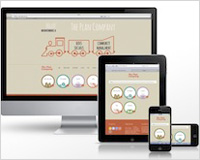 “The personal computer is the thing that’s always with you, always connected [and] has your stuff on it.” – Luke Wroblewski, Drupalcon Denver Keynote, March 2012
Your mobile phone is always with you. It’s always connected, and it has your stuff on it.
As designers we focus on creating with the user in mind, and that means paying attention to the user’s mobile. This need to keep mobile in mind has lead Luke Wroblewski and many others to tout the phrase “Mobile First,” meaning that the mobile experience should be designed and considered first and foremost with desktops a secondary consideration.
The pressure to create designs using the mobile first approach is not only present, but growing exponentially. John Doe may accept that a store’s web experience is more intuitive than the mobile experience, and Jane Doe may be ok knowing she has to use her computer to finish the taxes she began on her phone. But John and Jane’s patience is dwindling…
“The personal computer is the thing that’s always with you, always connected [and] has your stuff on it.” – Luke Wroblewski, Drupalcon Denver Keynote, March 2012
Your mobile phone is always with you. It’s always connected, and it has your stuff on it.
As designers we focus on creating with the user in mind, and that means paying attention to the user’s mobile. This need to keep mobile in mind has lead Luke Wroblewski and many others to tout the phrase “Mobile First,” meaning that the mobile experience should be designed and considered first and foremost with desktops a secondary consideration.
The pressure to create designs using the mobile first approach is not only present, but growing exponentially. John Doe may accept that a store’s web experience is more intuitive than the mobile experience, and Jane Doe may be ok knowing she has to use her computer to finish the taxes she began on her phone. But John and Jane’s patience is dwindling…
Mobile first
Cisco has projected that mobile connections will increase from 6billion today to 12billion in 2016 – just four years away. It’s not hard to grasp the importance of providing users with a solid mobile experience. So why is Mobile First so difficult to sell?1. Change is hard
Over the past 20 years web design has evolved from text-based sites, through Flash, CSS, and into Web 2.0. Through the years web design has taken a lot of cues from print design, and yet it still took 20 years with designers having to relearn some fundamental lessons. To look at one example, in the 1950s the International Style was created for print, pushing back on the overuse of ornamentation and decoration. This bears a striking resemblance to the lesson designers learned in the late-2000s, when sites went from Flash-heavy to clean and simple. Image via Shutterstock
Mobile is evolving so quickly that designers don’t have another 20 years to learn the process. Mobile designers can learn from web design, just as web learned from print, but there will be lessons to relearn and new technologies to explore. Therefore it’s unsurprising that the Mobile First principle is not an easy thing. It asks designers who are finally seeing a true integration of web and print design to change the process yet again – and change is hard.
Image via Shutterstock
Mobile is evolving so quickly that designers don’t have another 20 years to learn the process. Mobile designers can learn from web design, just as web learned from print, but there will be lessons to relearn and new technologies to explore. Therefore it’s unsurprising that the Mobile First principle is not an easy thing. It asks designers who are finally seeing a true integration of web and print design to change the process yet again – and change is hard.
2. Mobile is Expensive
In addition to change itself being difficult to grasp, adding mobile designers and developers can be pricy. Basic supply and demand explains part of the reason mobile designers and developers are as expensive as they are, but there’s an added challenge. Mobile development takes vastly more time than web, and mobile devices are also more resource-constrained; they have less memory and slower processors than computers. Designers need to be aware of how their designs impact development and consider how the developers will optimize for performance. All of that costs time, and time is money. Mobile First is all well and good, but many companies make it second – or third – when the money isn’t there to support it.3. What’s the Process?
As if pricing concerns weren’t enough, there’s the fact that Mobile First means different things to different people. For a manager, it means setting aside time for developers and designers to create wireframes and mockups for mobile in addition to web. For a front-end developer, it means considering responsive design or progressive enhancement options. But for the content creators, be they content strategists or designers, there’s another consideration – how do you decide what content belongs on mobile? Few designers have a clear answer to the question, which is the biggest reason that Mobile First is difficult to implement, even by companies that have accepted the need to innovate and have the money to do so. But the answer to how to create content is not apparent in the underlying principles of Mobile First. That’s why there’s a new maxim in town: Content First.Content First
“Content precedes design. Design in the absence of content is not design, it’s decoration.” – Jeffrey Zeldman Mobile First doesn’t mean anything to designers and content strategists without some details or tools. In order to design with mobile in mind, there must be something to say – to quote Margot Bloomstein, “What do you need to communicate? Why even do this…if you don’t know what you need to communicate?” Image via Shutterstock
This implies that there’s something that comes before, or alongside Mobile First – content strategists call it Adaptive Content. When content strategists write copy or suggest visuals to designers, they are telling a story, and creating adaptive content means remembering that Twitter, Facebook, RSS fees, mobile apps, and blogs will all repurpose the story. By creating adaptive content, content strategists ensure that their story can be broken down and simplified such that any medium can accurately retell it. Content strategists are given the tools to create adaptive content – and as a result they can provide designers and developers with the content they need to design for mobile.
Image via Shutterstock
This implies that there’s something that comes before, or alongside Mobile First – content strategists call it Adaptive Content. When content strategists write copy or suggest visuals to designers, they are telling a story, and creating adaptive content means remembering that Twitter, Facebook, RSS fees, mobile apps, and blogs will all repurpose the story. By creating adaptive content, content strategists ensure that their story can be broken down and simplified such that any medium can accurately retell it. Content strategists are given the tools to create adaptive content – and as a result they can provide designers and developers with the content they need to design for mobile.
AIDA
One tool for simplifying the story is a simple acrostic: AIDA. Neville Medhora promotes AIDA in his Kopywriting Kourse, and gives several examples of how it can be used to create content with any (or several) media in mind. The four words represented by AIDA are: A – Attention I – Interest D – Desire A – Action There are four steps corresponding to AIDA. The first, Attention refers to whatever first grabs the user's attention. It could be a word, image, headline, or graphic. It usually takes less than a second to sink in, and it might shock, amaze, or amuse the audience. The second, Interest is the element on the page (or tweet, or paragraph) that interests the user in continuing to read. This could be a title or subtitle, it might be the first sentence of a story, or it might be the caption on an image. Third comes the Desire, whether through a video or a bulleted list sharing details and increasing the user’s connection to the content. And last is Action, the button, link, or instruction that tells the user what to do next. By creating content that follows the AIDA needs, it becomes easier to tell a story in multiple mediums; after all, it’s easier to alter the story if you’re very clear on what it is, and how each piece connects to the user’s attention, interest, desire, and action.
File Sharing
Time is money, as we said, and managers everywhere are interested in working more efficiently. Sadly, there is a fallacy that people work better in silos, probably due to the fact that no one wants someone looking over their shoulder as they write or design. As a result, content strategists and designers who need to work collaboratively, struggle to find a method that works. File sharing has made collaborating far easier. With tools such as Dropbox or Google Docs, writers can provide copy at the same time that designers are working on screens. A 15-minute in-person check in, much like an agile scrum, can also go a long way to aiding collaboration. When a writer knows that he can create a first draft of copy and see how it looks within an hour or two it becomes much easier to write, and when a designer knows that copy is coming and designs can be tweaked to fit, getting started is less of a chore.Kick-Off Meetings
Somewhere along the way, meetings got a very bad rap in the world of design. And yet sometimes, getting the full team together to discuss every idea is the only way to kick-off. Ideally, a kick-off meeting is an opportunity for designers, developers, stakeholders, and content creators to sit together and listen to one another. Many project leads are afraid of inviting conflict, but content creators tend to prefer to hear the conflict come out at the beginning, rather than late in the game when designs and content will all need to be redone. More importantly, meetings are the place to prioritize features and functionality. This can also cause conflict, but if the whole team is genuinely interested in coming to an agreement on the project goals, then the conflict can be a positive and necessary thing. In addition, the more the content strategists and designers can learn about the team’s priorities, the easier it will be to create adaptive content that achieves these goals for both mobile and web.Learn Your Audience
Do your users have Android phones? iPhones? Do they download many apps? Are they comfortable entering credit cards on their mobile phones? Do they read on their phones? Do they use tablets? Do they watch movies on their laptops? Given the expense of adding a mobile developer to the team, it’s astonishing that more companies don’t consider their mobile needs before engaging in a mobile strategy. If the users aren’t interested in having a mobile component, then perhaps the mobile goals need to change. And the prevalence of online forums, online testing sites, and of course Facebook and Twitter leaves no excuse for not seeking out your users and discovering what they use and how they use it.Mobile First, User First, Content First
Mobile First and Content First are not principles in opposition. Far from it; Mobile First is a goal for designers and developers, and Content First is a tool to help achieve that goal. Sadly, it’s easy to let the barriers to Mobile First prevent your team from moving forward, but embracing Content First and the available tools to get there can get your design team ahead of the curve.Marli Mesibov
Marli Mesibov provides clients with a combination of content strategy and project management at a UX Design agency, Above the Fold. She is an active contributor to ATF’s blog, in addition to writing short stories in her spare time. Marli can also be found on Twitter, where she shares thoughts on UX Design, content strategy, and Muppets.
Read Next
15 Best New Fonts, July 2024
Welcome to our monthly roundup of the best fonts we’ve found online in the last four weeks. This month, there are fewer…
By Ben Moss
20 Best New Websites, July 2024
Welcome to July’s round up of websites to inspire you. This month’s collection ranges from the most stripped-back…
Top 7 WordPress Plugins for 2024: Enhance Your Site's Performance
WordPress is a hands-down favorite of website designers and developers. Renowned for its flexibility and ease of use,…
By WDD Staff
Exciting New Tools for Designers, July 2024
Welcome to this July’s collection of tools, gathered from around the web over the past month. We hope you’ll find…
3 Essential Design Trends, July 2024
Add some summer sizzle to your design projects with trendy website elements. Learn what's trending and how to use these…
15 Best New Fonts, June 2024
Welcome to our roundup of the best new fonts we’ve found online in the last month. This month, there are notably fewer…
By Ben Moss
20 Best New Websites, June 2024
Arranging content in an easily accessible way is the backbone of any user-friendly website. A good website will present…
Exciting New Tools for Designers, June 2024
In this month’s roundup of the best tools for web designers and developers, we’ll explore a range of new and noteworthy…
3 Essential Design Trends, June 2024
Summer is off to a fun start with some highly dramatic website design trends showing up in projects. Let's dive in!
15 Best New Fonts, May 2024
In this month’s edition, there are lots of historically-inspired typefaces, more of the growing trend for French…
By Ben Moss
How to Reduce The Carbon Footprint of Your Website
On average, a web page produces 4.61 grams of CO2 for every page view; for whole sites, that amounts to hundreds of KG…
By Simon Sterne
20 Best New Websites, May 2024
Welcome to May’s compilation of the best sites on the web. This month we’re focused on color for younger humans,…














